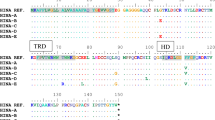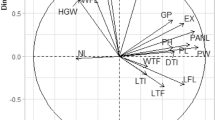Abstract
The polyphenol content in pearl barley, which is highly correlated to a browning reaction after heat treatment, was investigated using 1,347 cultivated barley varieties (H. vulgare) and two wild accessions (H. vulgare subsp. spontaneum) collected from different areas of the world. The polyphenol content in the cultivated barley shows a wide variation ranging from 0.19 to 0.75 mg/g with a nearly normal frequency distribution. The polyphenol content in the hulless varieties from Japan and Korea was low. On the other hand, the polyphenol content in wild barley was about two times higher than the average value recorded in cultivated barley. Based on HPLC analysis, five lowest-polyphenol content local varieties do not represent proanthocyanidin-free mutants.
Similar content being viewed by others
References
Bhatty, R.S., 1992. Dietary and nutritional aspects of barley in human food. Barley Genetics VI: 913–923.
Fujita, M., K. Takeda, N. Kohyama, E. Domon & Y. Doi, 2000. Variation in total polyphenol content and browning reaction after heat treatment in barley. Bull of Shikoku Natl Agric Exp Stn 65: 9–16. (In Japanese with English summary)
Kohyama, N. & M. Fujita, 2000. Effect of polyphenols on the browning reaction in barley paste after heating. Bull of Shikoku Natl Agric Exp Stn 65: 1–7. (In Japanese with English summary)
Jende-Strid, B., 1993. Genetic control of flavonoid biosynthesis in barley. Hereditas 119: 187–204.
Riis, P., P. Vaag & J. Peetz, 1995. Influence of barley variety on Fusarium field infection. Proc Eur Brew Conf, Brussels, pp. 117–124.
Sato, Y., 1995. Effect of pH, storage temperature, additives and polyphenols on browning reaction in barley processing. Bull of Fukui Agric Exp Stn 32: 43–49. (In Japanese with English summary)
Skadhauge, B., K.K. Thomsen & D. von Wettstein, 1997. The role of the barley testa layer and its flavonoid content in resistance to Fusarium infections. Hereditas 126: 147–160.
Yanagisawa, A. & Y. Amano, 1996. Degradation of flour color in wheat damaged by rain in Hokkaido. In: Kaz Noda & D.J. Mares (Eds.), Pre-Harvest Sprouting in Cereals 1995, pp. 19–26. Center for Academic Societies Japan, Osaka.
Author information
Authors and Affiliations
Rights and permissions
About this article
Cite this article
Fujita, M., Takeda, K., Kohyama, N. et al. Genotypic variation in polyphenol content of barley grain. Euphytica 124, 55–58 (2002). https://doi.org/10.1023/A:1015658305562
Issue Date:
DOI: https://doi.org/10.1023/A:1015658305562




